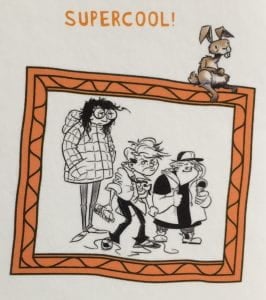
Living in Swaziland, Adele’s mother wants a better life for her daughter. Even though her father lives at a distance with his other family, Adele is well-supported and goes to a private school.
However, Adele finds things have changed when she returns to her boarding school after term-break. Her position in the ‘top girl’ group has been taken – by a girl whose father is more wealthy than her own. Worse still, she has been relegated to a room supposedly haunted by a dead student, and one she will share with an impoverished student, below her own social status.
Lottie is a uniquely bold student; either in spite of or because of her poor background. She is at Keziah Christian College as a supported student on a scholarship, and she takes no nonsense from anyone, even challenging teachers at times.
In contrast, Adele likes to keep things on an even keel. That is until her struggle with the top girls becomes heated and she has to choose a new path to get through the school term.
‘When the Ground is Hard’ is told by Malla Nunn, who was born in Swaziland and attended a mixed-race boarding school. The struggles of Adele and Lottie echo her own (and her mother’s) experiences in this #ownvoice story, as they battle to rise above the prejudices of racial segregation.
I wanted to tell a story that honoured the women and girls with whom I grew up – strong, brave, broken, vain, furious – girls who struggled to find their place in a racially segregated world where they, and I, were kept down for no good reason. (From Malla Nunn’s website.)
Adele and Lottie’s friendship is slow-growing but beautifully developed as they reluctantly team together. Once Adele’s changed status at school opens her eyes to the levels of prejudices and hardships faced by mixed-race girls and women (particularly strong in the 1960s when the novel is set) they begin to bond. Cleverly, this is enhanced as they read Jane Eyre together, and reflect on Jane’s experiences and their own destinies.
A book which touches on many issues. Highly recommended 14+
# Available as ebook.
 With so many great YA books about, it’s not often I pick up and review something for younger readers. However, I have just chuckled my way through the first book of ‘Derek Dool Supercool’ series – ‘Bust a Move’.
With so many great YA books about, it’s not often I pick up and review something for younger readers. However, I have just chuckled my way through the first book of ‘Derek Dool Supercool’ series – ‘Bust a Move’.
 How great is it to get a book which is written by, not one, but three renowned authors!
How great is it to get a book which is written by, not one, but three renowned authors! As already noted, it is also a collaboration between three talented Australian authors – Cath Cowley, Simmone Howell and Fiona Wood – and is soooo well done.
As already noted, it is also a collaboration between three talented Australian authors – Cath Cowley, Simmone Howell and Fiona Wood – and is soooo well done. “There are lots of things worse than school.”
“There are lots of things worse than school.” When we first meet Rob in ‘A Song Only I Can Hear’, he is shy, uncertain of himself, and in the throes of first love. He has a few significant people in his life, but not many friends. And a bully lingers at school.
When we first meet Rob in ‘A Song Only I Can Hear’, he is shy, uncertain of himself, and in the throes of first love. He has a few significant people in his life, but not many friends. And a bully lingers at school.
 Planning events these days will involve a playlist – that is, the significant songs that can be used during the event. Special songs for the wedding couple, meaningful songs for a birthday celebration, reminiscent songs for anniversaries. The Spotify generation can relate to this – and plan their playlist.
Planning events these days will involve a playlist – that is, the significant songs that can be used during the event. Special songs for the wedding couple, meaningful songs for a birthday celebration, reminiscent songs for anniversaries. The Spotify generation can relate to this – and plan their playlist.